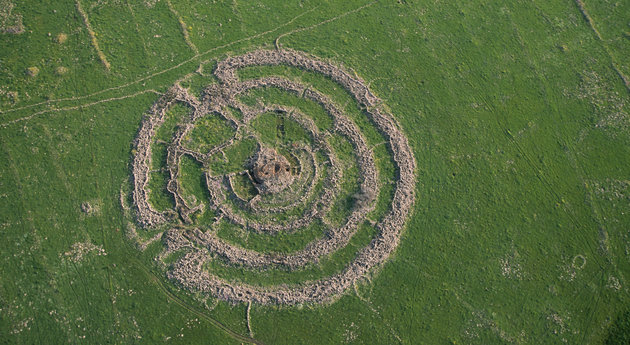A mysterious stone circle in the Middle East is estimated to be nearly 5,000 years old -- about the same age as Stonehenge.
It's known in Arabic as Rujm el-Hiri, or "stone heap of the wild cat," and Gilgal Refaim in Hebrew, which means "Wheel of Giants" and refers to a race of giants mentioned in the Bible.
"It's an enigmatic site. We have bits of information, but not the whole picture," Uri Berger, an expert on megalithic tombs with the Israel Antiquities Authority, told Reuters. "Scientists come and are amazed by the site and think up their own theories."
The Wheel of Giants, which sits in the contested Golan Heights, is so vast that it is best seen from the sky:

Unlike the massive rocks of Stonehenge, Rujm el-Hiri is made up of much smaller stones, with a total diameter of more than 500 feet, according to Popular Archaeology.
The website reports that the walls that make up the five circles have a height of up to 6.6 feet, with outer walls as high as 8 feet. The stones have a combined weight estimated at 37,500 tons.
But despite its massive size, it's not always easy to see how the whole site is connected from the ground level, where it may just look like rocks and rubble in places:
At the heart of the Wheel of Giants is a 15-foot-high burial mound; although who was buried there -- and whatever he or she was buried with -- were taken by tomb robbers long ago.
"All the five big, huge monumental walls around us are all, we think, were built for this chamber, the one who was buried inside it," Berger said in a Reuters video from inside the burial chamber. "This is one of the theories."
Some experts believe the Wheel was built by nomads. Others say the circles were built first for some other purpose, and that the tomb was added later.
A 2010 report in Biblical Archaeology Review said the circles may have been used as "an ancient calendrical device that indicated the arrival of the summer solstice and other astronomical events."
The same report said the tomb may have been added as much as 2,000 years after the circles were created.
A 2011 theory suggests the circle and burial mound were built at the same time and used for a version of "sky burials."
The bodies of the deceased would be placed at the top of the mound at the center for vultures to pick clean, and then the bones could be placed into ossuaries, according to the theory published in Biblical Archaeology Review by Dr. Rami Arav.
Popular Archaeology has more details on the theory -- and the Wheel itself -- here.
A number of "Big Circles" have been found throughout the Middle East, including about a dozen in Jordan and Syria.
Researcher David Kennedy told the Christian Science Monitor in 2014 that it's unclear what relationship the Big Circles may have to one another, but the similarities are "too close to be a coincidence."




Reader Comments
to our Newsletter